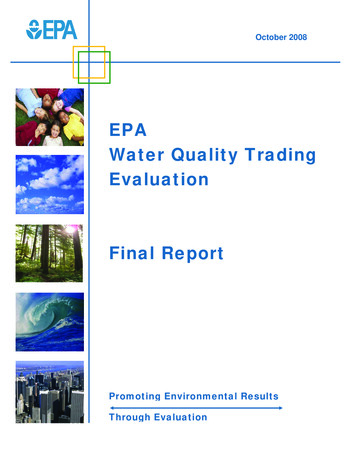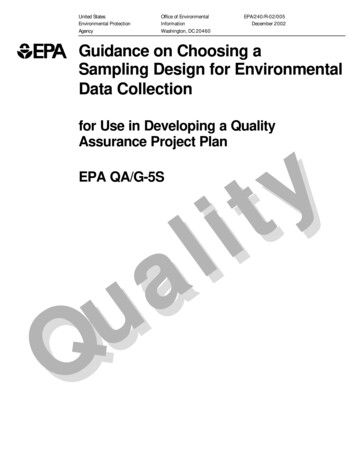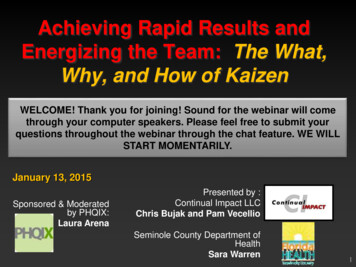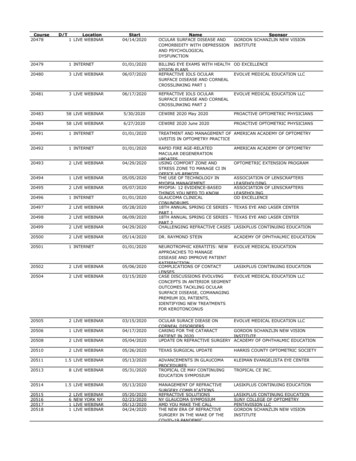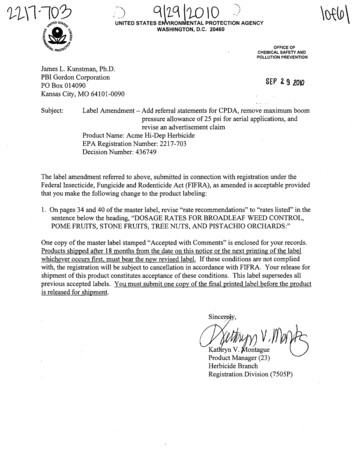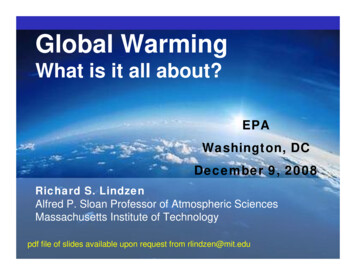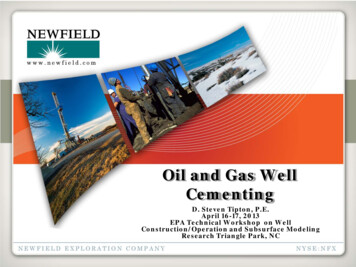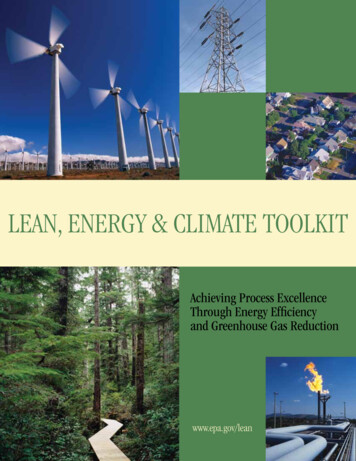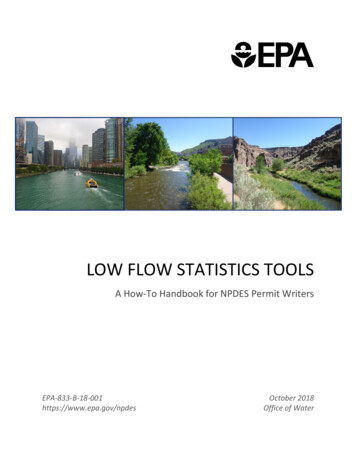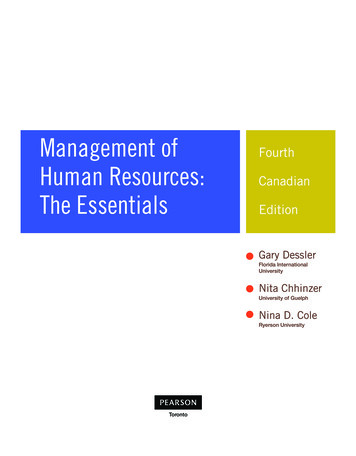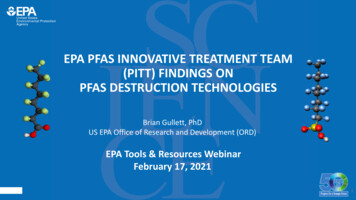
Transcription
EPA PFAS INNOVATIVE TREATMENT TEAM(PITT) FINDINGS ONPFAS DESTRUCTION TECHNOLOGIESBrian Gullett, PhDUS EPA Office of Research and Development (ORD)EPA Tools & Resources WebinarFebruary 17, 20211
Per- & Polyfluoroalkyl Substances (PFAS) A very large class of synthetic chemicals– Chains of carbon (C) atoms surrounded by fluorine (F)atoms, with different terminal ends– Complicated chemistry – thousands of differentvariations exist in commerce– Widely used in industrial processes and in consumerproducts– Mobile via multiple air, water pathways– Some PFAS are known to be PBT: Persistent in the environment Bioaccumulative in organisms Toxic at relatively low (ppt) levelsFluorinePFOAPFOS2
Outline EPA PFAS Innovative Treatment Team (PITT) Goals Challenges Non-Combustion Technologies Mechanisms Combustion Technologies Mechanisms Outputs Status and PITT Legacy, Next utputsNext Steps
PFAS Innovative Treatment Team (PITT) Full-time team of multi-disciplined EPA research staff Focused efforts and expertise on a single problem: how to remove,destroy, and test PFAS-contaminated media and waste For 6 months, the PITT worked to achieve the following goals: Assess current and emerging destruction methods being explored by EPA,universities, other research organizations and industry Explore the efficacy of methods while considering byproducts to avoid creatingnew environmental hazards Evaluate methods’ feasibility, performance and costs to validate onCombustionOutputsNext Steps
PITT Goals Develop a “Toolbox” of reviewed solution(s) for the destruction of PFAS inmedia and contaminated waste to meet the needs of EPA programs andregions, states and tribes, federal agencies, and industry Traditional (combustion) destruction Temperature and time conditions for C-F bond breakage Performance of flue gas cleaning systems Analysis of byproducts Innovative (high risk), non-traditional approaches Destruction performance Byproducts Provide decision makers with state of the science data on incinerationeffectiveness enabling them to better manage end-of-life disposal of PFAScontaining ionOutputs Next Steps
PFAS Sources Considered Biosolids, sludge Aqueous film forming foam (AFFF)contaminated soils AFFF concentrate, spent AFFF Municipal Waste Combustors(MWCs), landfills, landfill leachate Spent granular activated carbon(GAC), anion exchange OutputsNext Steps
PITT Challenges COVID-19 Building closuresLab closuresRestricted partner access to labsClosure of suppliersUnavailable instrument repairs Finding field test partners Concurrent field sampling and sampling onCombustionOutputsNext Steps
Challenges of PFAS Destruction Complicated chemistry ‒ thousands of PFAS exist Widely used in industrial processes and consumerproducts Efficacy of thermal treatment 90 ⁰C C-F bond is the strongest bond in organic chemistry Emission sampling and analytical methods are underdevelopment Volatile, non-volatile, polar, non-polar Limited number of analytical standards available Field data lacking Historical laboratory research on “destructibility” lacksinformation about products of incomplete combustion OutputsNext Steps
Non-Combustion Technologies Selected beamUVSupercritical water oxidationDeep well fillLand applicationPyrolysisPITTGoalsChallengesAssessment Factors: Technology readiness Applicability Cost Required development remaining Risk/reward of technology adoptionAssessment Methods: Subject matter expert discussions Literature reviews PITT discussionsTechnologies selected for sNext Steps
Mechanochemical TreatmentWorks by: Introduction of dry solids into a ball mill Co-milling reagents: Al, Fe, SiO2, CaO, MgO, Al2O3, KOH,NaOH, MnO2, TiO2 High energy ball impacts fracture solids generating localizedhigh temperatures and radicals that react and breakdownorganic molecules Technology derived from Persistent Organic Pollutants(POPs)-contaminated soil treatment EDL (NZ) showed 99.8% DRE of PCBs in 45 min (USNavy, Hunters Point, 2006).Status: Contract with EDL (New Zealand) AFFF impacted soil study 99% destruction of targeted PFAS AFFF destruction study AFFF added to sand 99% destruction of targeted PFASY·Bulley, M.; Black, B. tputsNext StepsC(s) CO2 F-
Electrochemical TreatmentWorks by: A high overpotential ( 3 V) is applied toan electrolytic cell Stepwise degradation ultimatelyproduces CO2 and fluorideStatus: Testing AECOM reactors Dilute AFFF Data gaps: Uncertain byproducts Volatile loss Matrix effects Results expected by May ’21 36 targeted PFAS TOP (precursors assay) TOF (total organic tionOutputsNext Steps
Supercritical Water Oxidation (SCWO)Works by:At T 374oC and P 221 Bar, waterbecomes supercriticaland organics aresolubilized and oxidizedStatus: Focus on AFFF concentrate (stockpile destruction alternative) In-house lab study on Hydrothermal oxidation Progressing on track Experiments complete, chemical analysis complete Up to 99% destruction of targeted PFAS seen by 3 vendors Aquarden (Denmark) – Analyzed targeted PFAS Battelle’s SCWO “Annihilator” – Analyzed targeted PFAS and fluoride 374Water/Duke – Analyzed targeted PFAS, TOF, and fluoride General Atomics MCRADA – Plan under review, experiment in summer OutputsNext Steps
SCWO StatusAFFFConcentrateMCRADA signedGeneral Atomics:Aquarden:Battelle:Bench Scale100x dilute AFFF concentrateTarget PFAS in and out (liquid)Archived samples (non-target)13PITTWorking unit (pilot test)100x dilute AFFF concentrateTarget PFAS in and out (liquid)GoalsChallenges374Water:Pilot scale (Test #1: 9/10/20)4 experiments, varying dilute AFFFTarget PFAS in and out (liquid)Archived samples (non-target)Canister and sorbent samples (air)Non-CombustionCombustionOutputsWorking unit (pilot test)Varying dilute AFFFTarget PFAS in and out (liquid)Archived samples (non-target)Canister and sorbent samples (air)Next Steps
Biosolids Pyrolysis/GasificationWorks by: Pyrolysis is a process that decomposes materials atmoderately elevated temperatures in an oxygen-freeenvironment. Gasification is similar to pyrolysis but uses smallquantities of oxygen, taking advantage of the partialcombustion process to provide the heat to operatethe process. The oxygen-free environment in pyrolysis and the lowoxygen environment of gasification distinguish thesetechniques from incineration. Pyrolysis, and certain forms of gasification, cantransform input materials, like biosolids, into abiochar while generating a hydrogen-rich syntheticgas (syngas).Status: Field test of Pyrolysis unit (with emission controls)that produces Biochar with energy to a biosolidsdryer Field test completed 2020 and sampled for PFAS in:- Input Biosolids- Produced Biochar- Scrubber Water- Multi-position FTIR No reportable PFAS found in produced biochar, butadditional research needed to understand potentialreleases to air and water.BioForceTechcommercial OutputsNext Steps
Combustion TechnologiesStatusWorks by: Bond breakage via gasphase oxidation reactionswith organic PFAS Ideally, formation of CO2,H2O and HF HF removed in acid gasscrubber15PITTGoals Laboratory studies At EPA (Rainbow furnace) Indicators for Destruction RemovalEfficiency (DRE) and Products ofIncomplete Combustion (PICs) FTIR applicability At University of Dayton Research Institute Temperature (T), time (t) effects Byproducts Flame radical studies Spent GAC/Ion Exchange resin Pursuing field sampling efforts at facilities withdifferent types of combustion process Muncipal Waste Wastewater Treatment Rotary Kiln utsRainbow FurnaceRTP, NC campusNext Steps
WasteCharacterizationGuide on Waste/TechnologyApplicability and DesignConsiderations – WasteCharacteristicsSpent GAC/AEX Excavated solids, low PFAS/soil mass ratio,high volumesBiosolids/Sludges High moisture content, relatively low PFASconcentrations, co-contaminantsLeachatePITTGoalsChallenges Spent GAC & AEX are solids with binding sites saturatedwith a combination of PFAS and co-contaminantsSoilsAFFF & Spent AFFF16Waste ScaleNon-Combustion Liquid phase, legacy AFFF 5% PFAS Spent AFFF is dilute Liquid phase with organic co-contaminantsCombustionOutputsNext Steps
Treatment SelectionSystem SizingCrosswalk of Wastesand Technologies –Design Issues Continuous vs.Batch Processing Level of treatmentrequired Transportability Centralized ss ManagementWaste Steams Phase of materialto be treated Chemical Inputs Energy Inputs Capital andOperating Costs Lifecycleconsiderations Side StreamGeneration Phase Change? Additional UnitProcess Treatment(e.g., PollutionControl Devices)Final Disposition Further treatmentof co-contaminants Disposal ritical TGoalsInnovative TreatmentTechnologiesEngineering Design Considerations Size is a function of kinetics and reactorconfiguration High lifecycle and operating costs Minimum concentration thresholdHigh lifecycle and operating costsTechnically complexSize is a function of kinetics and reactorconfiguration May be limited by water conc. allowableNon-Combustion Degradation byproducts may vary Potential corrosion issues Likely generates gas phase waste stream Ancillary unit operations are necessary Pretreatment of solids to reduce water Volatiles require treatment Can be batch or continuous Dry or semi-dry solids onlyChallenges May generate gas phase waste stream Can generate perchlorate in the presence of Cl17CombustionOutputsNext Steps
PFAS problem5 waste characteristics4 innovative technologiesCrosswalk of wastes and technologiesTechnology readiness levelDeployment Development MechanochemicalMillingN/AN/ATRLSoilsN/AN/ATRL 58TRL 1Biosolids/SludgesN/ATRL 56TRL 1TRL 79TRL 5/61,2TRL 54,5,6,7N/AN/AN/AN/ATRL 43LeachatePITTGoalsTRL 45Challenges210TRL 1Non-CombustionBasic Principles observed2Technology concept formulated3Experimental proof of concept4Technology validated in lab5Technology validated in relevant environment6Technology demonstrated in relevant environment7System prototype demonstration in operational environment8System complete and qualified9Actual system proven in operational environmentPyrolysisSpent GAC/AEXUnused andspent wledge/faqs/technology-readiness-levelsTRLs of Technology & PFAS MatricesElectrochemicalResearchPITT Introductory Paper on Four InnovativeTechnologies StudiedPhase TRL DescriptionCombustionBASIS1 (AECOM)2(Schaeferet al 2019)3 (Pierpaoli et al 2020)4 (General Atomics)5 ch)10(PITT)OutputsNext Steps
PITT Research cal OxidationGoalsChallengesNon-CombustionBall MillingCombustionPyrolysis & GasificationOutputsNext Steps
Challenge Partners US Dept. of Defense: Strategic EnvironmentalResearch and Development Program (SERDP) &Environmental Security Technology CertificationProgram (ESTCP) Environmental Council of the States(ECOS)/Environmental Research Institute of theStates (ERIS) Colorado Department of Public Health &Environment Michigan Department of Environment, GreatLakes, & ys-destroy-pfas-challenge Goal: Novel, alternative, non-incineration methodologies that offer apathway to complete destruction of PFAS compounds found in unused PFAScontaining aqueous film forming foam (AFFF), a type of fire suppressantagent, while not creating hazardous byproducts Up to 50K for the best design concept for non-thermal bustionOutputsNext Steps
The numbers:Challenge StatusAugSeptNov21 25th Challenge Launched 16th Public Webinar Est 500 Participants 23rd Challenge ClosedDec 18th First round judging complete Some solvers notified of eliminationJan 18th Judging Panel Selection 25th Propose Winners to ManagementFeb 212 solvers 64 submissions from 18 countries 23 solvers met the minimum acceptable criteria Winner onOutputsNext Steps
Summary of PITT Findings Preliminary results in laboratory and pilot-scale treatment systems demonstrateup to 99% loss of the initial PFAS compounds in the contaminated waste Thermal incineration/combustionSupercritical water oxidationPyrolysis/gasificationElectrochemical oxidation, andMechanochemical treatment. Still unknown, however, is what PFAS byproducts, if any, are formed from eachof these mbustionOutputsNext Steps
Next Steps Continue laboratory and pilot-scale research and development efforts on: Non-combustion, innovative technologies Thermal catalytic/incineration/combustion,Supercritical water oxidation,Pyrolysis/gasification,Electrochemical oxidation, andMechanochemical treatment. Thermal/combustion technologies Identify potential fluorinated byproducts formed during the application of thesetreatment approaches (non-target compound analyses) Explore opportunities for field sampling, development efforts with industrial and utilityfacilities Summarize efforts on non-combustion, innovative technologies in scientific papers(spring 2021) Promote next stage development for winners of the Innovative Ways to Destroy mbustionOutputsNext Steps
ContactsBrian GullettLead, PITT TeamCenter for Environmental Measurementand ModelingUS EPA Office of Research and Development919-541-1534Gullett.Brian@epa.govTim WatkinsDirectorCenter for Environmental Measurementand ModelingUS EPA Office of Research and tment-team-pitt24The views expressed in this presentation are those of the author and do not necessarily represent the views orpolicies of the US EPA. Any mention of trade names, products, or services does not imply an endorsement by the USGovernment or EPA. EPA does not endorse any commercial products, services, or enterprises.
Combustion Outputs Next Steps. Y C (s) CO. 2 F-· Bulley, M.; Black, B. EDL. Status: Contract with EDL (New Zealand) AFFF impacted soil study 99% destruction of targeted PFAS AFFF destruction study AFFF added to sand
